陕西省某二中2013届高三英语二轮复习精品课件:情景交际
文档属性
| 名称 | 陕西省某二中2013届高三英语二轮复习精品课件:情景交际 | 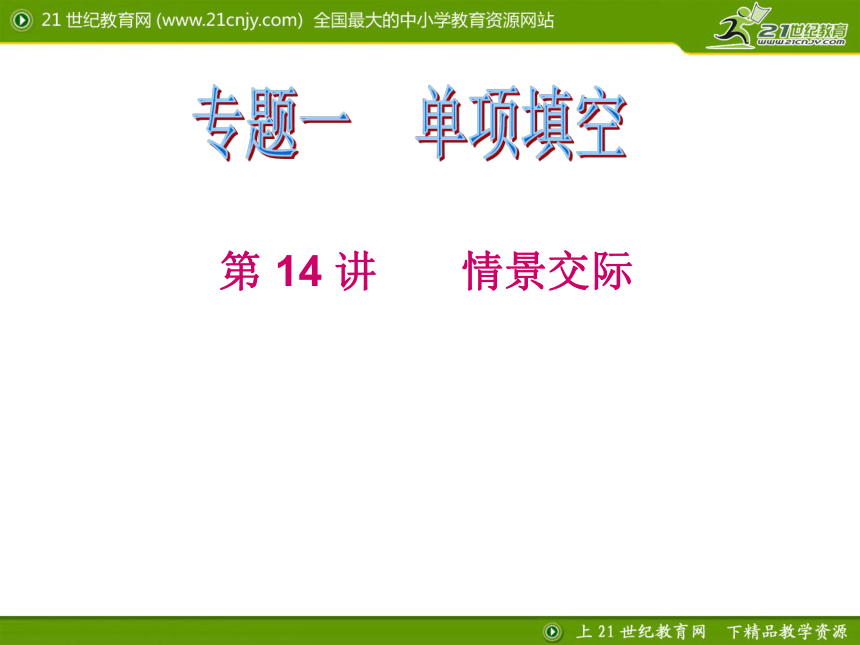 | |
| 格式 | zip | ||
| 文件大小 | 158.1KB | ||
| 资源类型 | 教案 | ||
| 版本资源 | |||
| 科目 | 英语 | ||
| 更新时间 | 2012-06-22 14:49:48 | ||
图片预览

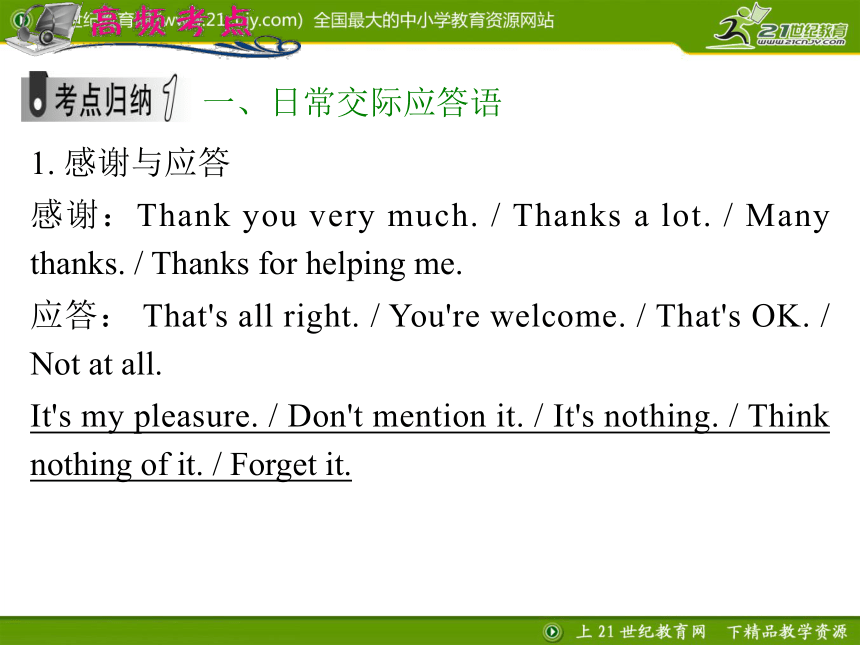
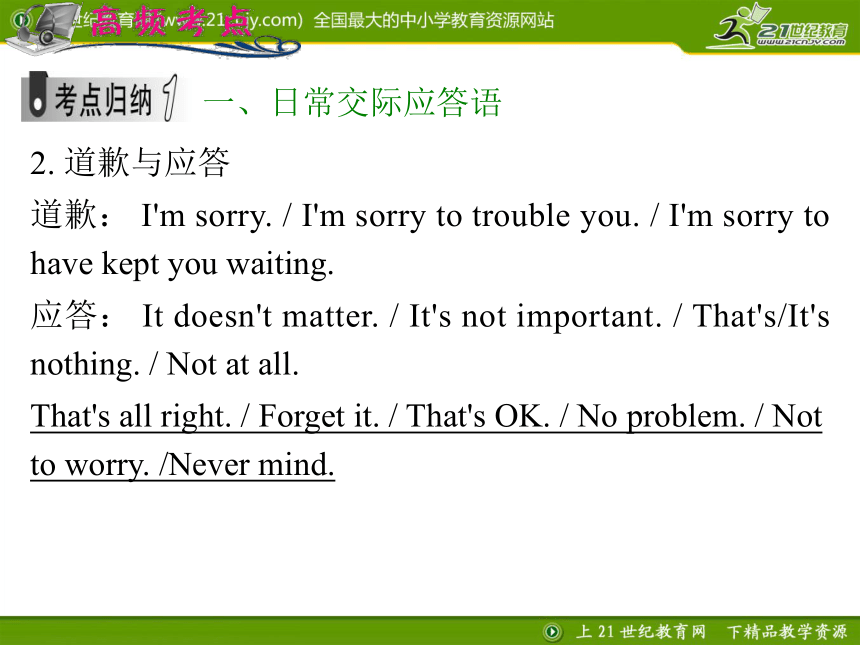
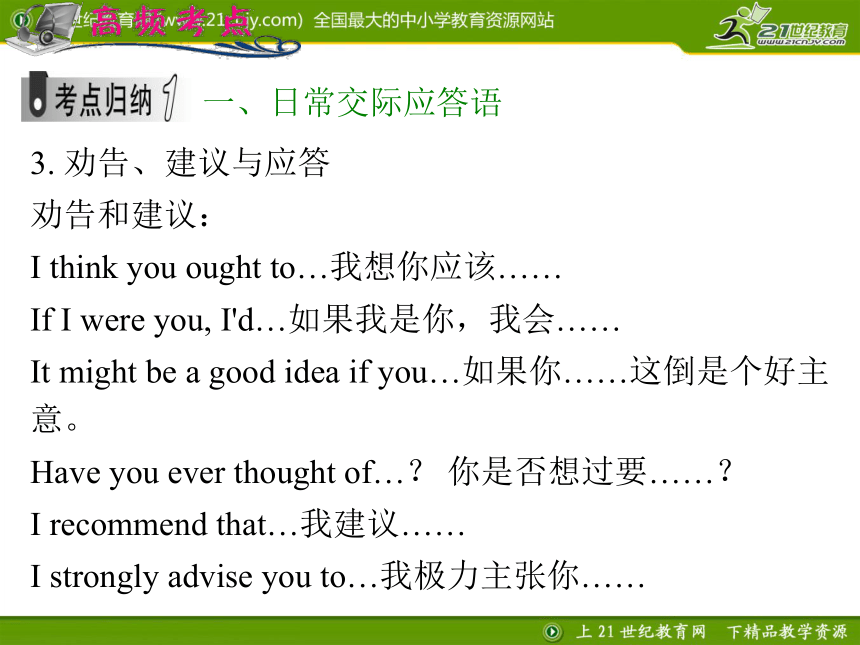
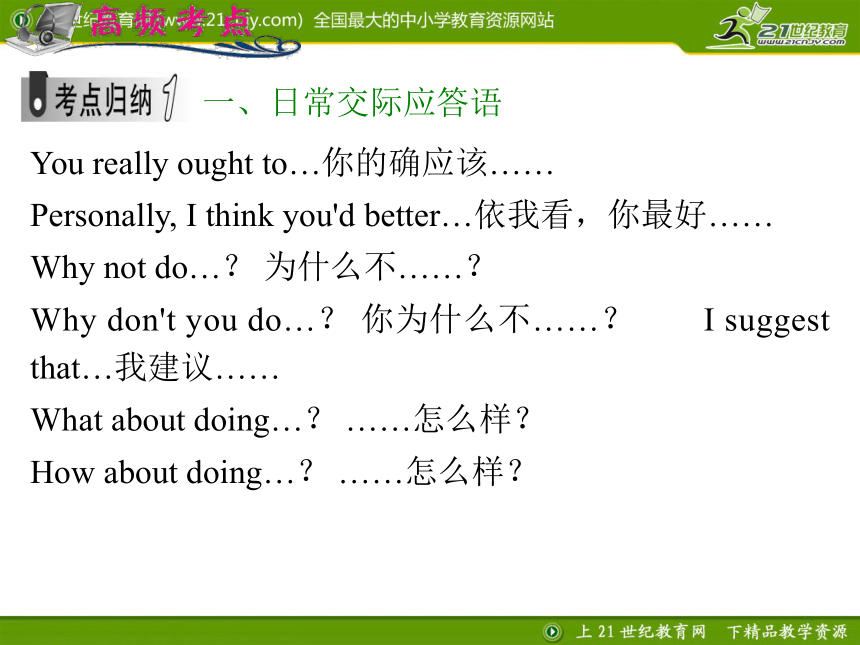


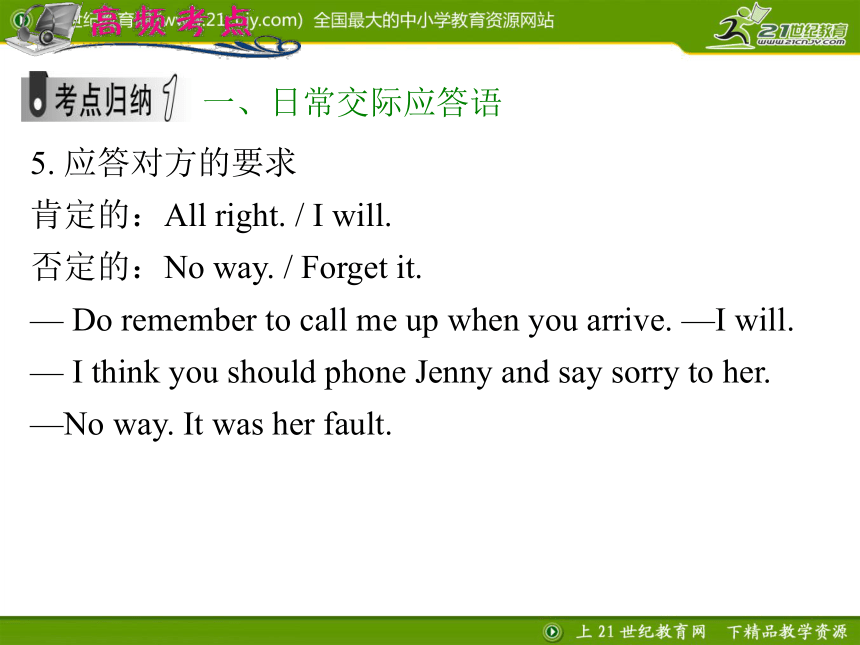
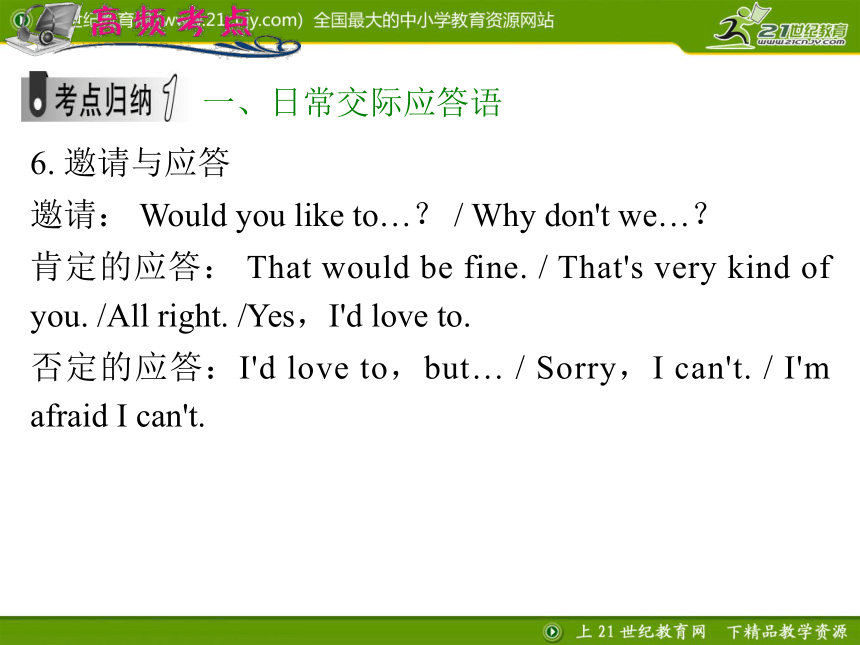
文档简介
(共23张PPT)
第 14 讲 情景交际
1. 感谢与应答
感谢:Thank you very much. / Thanks a lot. / Many thanks. / Thanks for helping me.
应答: That's all right. / You're welcome. / That's OK. / Not at all.
It's my pleasure. / Don't mention it. / It's nothing. / Think nothing of it. / Forget it.
一、日常交际应答语
2. 道歉与应答
道歉: I'm sorry. / I'm sorry to trouble you. / I'm sorry to have kept you waiting.
应答: It doesn't matter. / It's not important. / That's/It's nothing. / Not at all.
That's all right. / Forget it. / That's OK. / No problem. / Not to worry. /Never mind.
一、日常交际应答语
3. 劝告、建议与应答
劝告和建议:
I think you ought to…我想你应该……
If I were you, I'd…如果我是你,我会……
It might be a good idea if you…如果你……这倒是个好主意。
Have you ever thought of…? 你是否想过要……?
I recommend that…我建议……
I strongly advise you to…我极力主张你……
一、日常交际应答语
You really ought to…你的确应该……
Personally, I think you'd better…依我看,你最好……
Why not do…? 为什么不……?
Why don't you do…? 你为什么不……? I suggest that…我建议……
What about doing…? ……怎么样?
How about doing…? ……怎么样?
一、日常交际应答语
Shall we…? 我们去……好吗?
Let's…, shall we 让我们去……好吗?
You need (to)…你需要……
肯定的应答: Good idea. / That's great. / Sounds great. / It sounds great. / That's fine. /Why not
否定的应答:I'd love to,but… / I'm afraid… / It's an idea,but…
一、日常交际应答语
4. 请求与应答
请求: May I…? / Can I / Could I…? / Do you mind if I…
肯定的应答: With pleasure. / Certainly(Of course) / Sure,go ahead. / Yes,help yourself.
Of course not,go ahead(回答Do you mind if I…的请求).
否定的应答:I'm afraid not. / Better not. / I'd rather you didn't.
一、日常交际应答语
5. 应答对方的要求
肯定的:All right. / I will.
否定的:No way. / Forget it.
— Do remember to call me up when you arrive. —I will.
— I think you should phone Jenny and say sorry to her.
—No way. It was her fault.
一、日常交际应答语
6. 邀请与应答
邀请: Would you like to…? / Why don't we…?
肯定的应答: That would be fine. / That's very kind of you. /All right. /Yes,I'd love to.
否定的应答:I'd love to,but… / Sorry,I can't. / I'm afraid I can't.
一、日常交际应答语
7. 祝愿、祝贺与应答
祝愿、祝贺: Good luck! / Best wishes to you. /Have a nice/good time/journey. /Congratulations!
Happy New Year! / Merry Christmas! / Happy birthday to you.
应答: Thank you! / The same to you. / You,too. / Happy New Year!(Merry Christmas!)
一、日常交际应答语
8. 鼓励、赞扬与应答
鼓励、赞扬: Very good. / Well done. /Wonderful. /Excellent. /Keep trying. /You can do it.
应答: Thank you. / OK. /I'll try it again.
一、日常交际应答语
9. 提供帮助与应答
主动提供帮助时:Can I help you /What can I do for you /Would you like me to help you
Do you want me to… / Let me…
需要别人帮助时:Yes,please. / Thank you for your help/ Thanks.
不需要别人帮助时:No,thank you./ Thank you all the same. / That's very kind of you, but…
一、日常交际应答语
1. 表示惊奇:Really / How come?(何以会……?) / What a surprise! /Good heavens!
2. 表示同情: I'm sorry to hear that. / What a pity! / That's really unlucky. / Bad luck.
3. 表示安慰: Don't worry. / Don't be afraid. / Take your time. / Take it easy.
Make yourself at home. / It's quite all right. / It'll be OK.
4. 表示鼓励: Come on. / Cheer up. / You can do it. / You will make it.
二、情感态度的表达
5. 表示同意: I quite agree. / I couldn' t agree more. / Exactly. /Certainly. /Absolutely.
That's a good idea. / No problem. / I think so.
6. 表示不同意: Not really. / Not Exactly. / I don't quite agree. /I don't think so. / I'm afraid not.
7. 表示不在乎: So what / Who cares
二、情感态度的表达
解答情景交际题时要做到“四忌”
一忌上词下用
上词下用指的是答句部分沿用了题干句子的重点词、信息词,按表层意思似乎合情合理,但往往为错误的“虚像”,需经进一步分析后才能确定正确选项。如:
用“I don't”应答“Don't forget to come to my birthday party tomorrow”,
易错易混点
用“Don't be sorry”回答“I'm sorry I broke your mirror”,
用“No thanks”回答“Thank you ever so much for the book you sent me.”
避免“上词下用”的误区,一是确认题目涉及的交际功能项目,二是确认句子上下文语境,三是确认正确的话语方式。
易错易混点
【例题】 — I wonder if I could use your telephone.
— ______.
A. I wonder how B. I don't wonder
C. Sorry, it's out of order D. No wonder, here it is.
【答案及解析】 C 尽管该题中反复出现“wonder”一词,但通过仔细审题可确定其考查的功能项目为征求对方意见,问句相当于“Could I use your telephone?”综合语境和话题的分析,正确的答话方式一般为“Of course you can”(肯定)或“Sorry,you can't”(否定),也只有C项(抱歉,它坏了)符合题意,A、B、D项均属典型的“上词下用”现象,而且D项中的“No wonder”意思为“难怪”,更是和题干内容相差甚远。
易错易混点
二忌中文思维
与上词下用比较,这一误区更具迷惑性,因为无论按题目内容或是按思维方式来考虑,都非常符合中国学生的习惯。显然,掌握英汉两种语言和文化之间的相同和相异之处,对于准确解题至关重要。考生解题失误之一是按汉语的表达方式和结构去套英语,去选答案,这属于语言知识的“负迁移”。
易错易混点
【例题】 — Do you think it's going to rain over the weekend
— ______.
A. I don't believe B. I don't believe it
C. I believe not so D. I believe not
【答案及解析】 D 以Do you think…?这样的句子来提问,用D项来回答表示否定,显然不符合中文的表达习惯,这也正是许多考生选了A、B、C项的原因。另一个更常见的失误是套用中国文化模式。违背英语国家的思维方式和文化习俗,这属于文化方面的“负迁移”。
易错易混点
三忌直接回绝
这主要是指在对方要求得到帮助,提出请求或邀请时,回答过于直接,不够委婉,尽管从语义角度分析是没毛病的,但不符合英语国家的交际习惯。“请求”方面的问话有May I…?/Can I…?/I wonder if I could…/Do you mind if I…?等,“邀请”方面的问话有Will you…?/Would you like to…?/I'd like to invite to…等。在作否定回答时,为了表示礼貌和委婉,通常要用一些委婉词,如but,I'm afraid, I'm sorry, thanks, please, had better等。
易错易混点
【例题】 — I didn't know this was a one way street, officer.
— ______
A. That's all right. B. I don't believe you.
C. How dare you say that D. Sorry, but that's no excuse.
【答案及解析】 D 许多考生有可能选B、C项,这是没有注意到西方人生活、工作中交往的必要礼节,答话时过于生硬,没有顾及他人感情,而正确答案D项正是在充分考虑到说话双方的身份,彼此之间的关系以及说话人的立场和态度的基础上做出的选择。
易错易混点
四忌答非所问
答非所问的错误比较容易察觉,如果问话与答话的内容风马牛不相及的话,考生可以迅速排除。但有时双方会话内容有所关联,仔细推敲才发现其实答语并不切题。最典型的例子是With pleasure和It's a pleasure。前者一般在事前回答,表示“非常愿意”。后者一般在事后回答,表示“不用客气”。
易错易混点
【例题】 — Sorry, I couldn't come to the party. I was sick that day.
— ______.
A. I don't know that B. That's all right
C. Yes, we'll have another party
D. No, the party wasn't held
【答案及解析】 B A、C和D三项均明显地答非所问,与问句无关;只有B项能够作出直接的答复。
易错易混点
第 14 讲 情景交际
1. 感谢与应答
感谢:Thank you very much. / Thanks a lot. / Many thanks. / Thanks for helping me.
应答: That's all right. / You're welcome. / That's OK. / Not at all.
It's my pleasure. / Don't mention it. / It's nothing. / Think nothing of it. / Forget it.
一、日常交际应答语
2. 道歉与应答
道歉: I'm sorry. / I'm sorry to trouble you. / I'm sorry to have kept you waiting.
应答: It doesn't matter. / It's not important. / That's/It's nothing. / Not at all.
That's all right. / Forget it. / That's OK. / No problem. / Not to worry. /Never mind.
一、日常交际应答语
3. 劝告、建议与应答
劝告和建议:
I think you ought to…我想你应该……
If I were you, I'd…如果我是你,我会……
It might be a good idea if you…如果你……这倒是个好主意。
Have you ever thought of…? 你是否想过要……?
I recommend that…我建议……
I strongly advise you to…我极力主张你……
一、日常交际应答语
You really ought to…你的确应该……
Personally, I think you'd better…依我看,你最好……
Why not do…? 为什么不……?
Why don't you do…? 你为什么不……? I suggest that…我建议……
What about doing…? ……怎么样?
How about doing…? ……怎么样?
一、日常交际应答语
Shall we…? 我们去……好吗?
Let's…, shall we 让我们去……好吗?
You need (to)…你需要……
肯定的应答: Good idea. / That's great. / Sounds great. / It sounds great. / That's fine. /Why not
否定的应答:I'd love to,but… / I'm afraid… / It's an idea,but…
一、日常交际应答语
4. 请求与应答
请求: May I…? / Can I / Could I…? / Do you mind if I…
肯定的应答: With pleasure. / Certainly(Of course) / Sure,go ahead. / Yes,help yourself.
Of course not,go ahead(回答Do you mind if I…的请求).
否定的应答:I'm afraid not. / Better not. / I'd rather you didn't.
一、日常交际应答语
5. 应答对方的要求
肯定的:All right. / I will.
否定的:No way. / Forget it.
— Do remember to call me up when you arrive. —I will.
— I think you should phone Jenny and say sorry to her.
—No way. It was her fault.
一、日常交际应答语
6. 邀请与应答
邀请: Would you like to…? / Why don't we…?
肯定的应答: That would be fine. / That's very kind of you. /All right. /Yes,I'd love to.
否定的应答:I'd love to,but… / Sorry,I can't. / I'm afraid I can't.
一、日常交际应答语
7. 祝愿、祝贺与应答
祝愿、祝贺: Good luck! / Best wishes to you. /Have a nice/good time/journey. /Congratulations!
Happy New Year! / Merry Christmas! / Happy birthday to you.
应答: Thank you! / The same to you. / You,too. / Happy New Year!(Merry Christmas!)
一、日常交际应答语
8. 鼓励、赞扬与应答
鼓励、赞扬: Very good. / Well done. /Wonderful. /Excellent. /Keep trying. /You can do it.
应答: Thank you. / OK. /I'll try it again.
一、日常交际应答语
9. 提供帮助与应答
主动提供帮助时:Can I help you /What can I do for you /Would you like me to help you
Do you want me to… / Let me…
需要别人帮助时:Yes,please. / Thank you for your help/ Thanks.
不需要别人帮助时:No,thank you./ Thank you all the same. / That's very kind of you, but…
一、日常交际应答语
1. 表示惊奇:Really / How come?(何以会……?) / What a surprise! /Good heavens!
2. 表示同情: I'm sorry to hear that. / What a pity! / That's really unlucky. / Bad luck.
3. 表示安慰: Don't worry. / Don't be afraid. / Take your time. / Take it easy.
Make yourself at home. / It's quite all right. / It'll be OK.
4. 表示鼓励: Come on. / Cheer up. / You can do it. / You will make it.
二、情感态度的表达
5. 表示同意: I quite agree. / I couldn' t agree more. / Exactly. /Certainly. /Absolutely.
That's a good idea. / No problem. / I think so.
6. 表示不同意: Not really. / Not Exactly. / I don't quite agree. /I don't think so. / I'm afraid not.
7. 表示不在乎: So what / Who cares
二、情感态度的表达
解答情景交际题时要做到“四忌”
一忌上词下用
上词下用指的是答句部分沿用了题干句子的重点词、信息词,按表层意思似乎合情合理,但往往为错误的“虚像”,需经进一步分析后才能确定正确选项。如:
用“I don't”应答“Don't forget to come to my birthday party tomorrow”,
易错易混点
用“Don't be sorry”回答“I'm sorry I broke your mirror”,
用“No thanks”回答“Thank you ever so much for the book you sent me.”
避免“上词下用”的误区,一是确认题目涉及的交际功能项目,二是确认句子上下文语境,三是确认正确的话语方式。
易错易混点
【例题】 — I wonder if I could use your telephone.
— ______.
A. I wonder how B. I don't wonder
C. Sorry, it's out of order D. No wonder, here it is.
【答案及解析】 C 尽管该题中反复出现“wonder”一词,但通过仔细审题可确定其考查的功能项目为征求对方意见,问句相当于“Could I use your telephone?”综合语境和话题的分析,正确的答话方式一般为“Of course you can”(肯定)或“Sorry,you can't”(否定),也只有C项(抱歉,它坏了)符合题意,A、B、D项均属典型的“上词下用”现象,而且D项中的“No wonder”意思为“难怪”,更是和题干内容相差甚远。
易错易混点
二忌中文思维
与上词下用比较,这一误区更具迷惑性,因为无论按题目内容或是按思维方式来考虑,都非常符合中国学生的习惯。显然,掌握英汉两种语言和文化之间的相同和相异之处,对于准确解题至关重要。考生解题失误之一是按汉语的表达方式和结构去套英语,去选答案,这属于语言知识的“负迁移”。
易错易混点
【例题】 — Do you think it's going to rain over the weekend
— ______.
A. I don't believe B. I don't believe it
C. I believe not so D. I believe not
【答案及解析】 D 以Do you think…?这样的句子来提问,用D项来回答表示否定,显然不符合中文的表达习惯,这也正是许多考生选了A、B、C项的原因。另一个更常见的失误是套用中国文化模式。违背英语国家的思维方式和文化习俗,这属于文化方面的“负迁移”。
易错易混点
三忌直接回绝
这主要是指在对方要求得到帮助,提出请求或邀请时,回答过于直接,不够委婉,尽管从语义角度分析是没毛病的,但不符合英语国家的交际习惯。“请求”方面的问话有May I…?/Can I…?/I wonder if I could…/Do you mind if I…?等,“邀请”方面的问话有Will you…?/Would you like to…?/I'd like to invite to…等。在作否定回答时,为了表示礼貌和委婉,通常要用一些委婉词,如but,I'm afraid, I'm sorry, thanks, please, had better等。
易错易混点
【例题】 — I didn't know this was a one way street, officer.
— ______
A. That's all right. B. I don't believe you.
C. How dare you say that D. Sorry, but that's no excuse.
【答案及解析】 D 许多考生有可能选B、C项,这是没有注意到西方人生活、工作中交往的必要礼节,答话时过于生硬,没有顾及他人感情,而正确答案D项正是在充分考虑到说话双方的身份,彼此之间的关系以及说话人的立场和态度的基础上做出的选择。
易错易混点
四忌答非所问
答非所问的错误比较容易察觉,如果问话与答话的内容风马牛不相及的话,考生可以迅速排除。但有时双方会话内容有所关联,仔细推敲才发现其实答语并不切题。最典型的例子是With pleasure和It's a pleasure。前者一般在事前回答,表示“非常愿意”。后者一般在事后回答,表示“不用客气”。
易错易混点
【例题】 — Sorry, I couldn't come to the party. I was sick that day.
— ______.
A. I don't know that B. That's all right
C. Yes, we'll have another party
D. No, the party wasn't held
【答案及解析】 B A、C和D三项均明显地答非所问,与问句无关;只有B项能够作出直接的答复。
易错易混点
